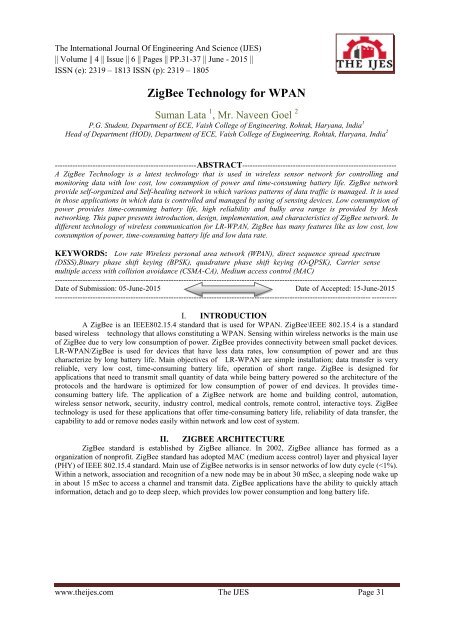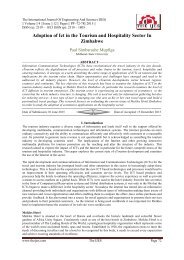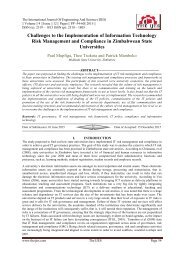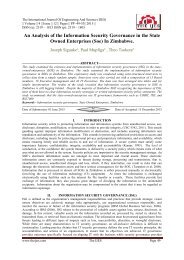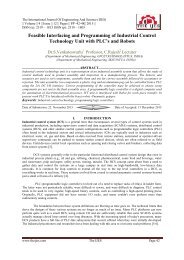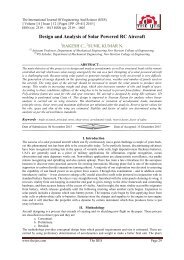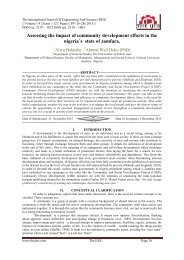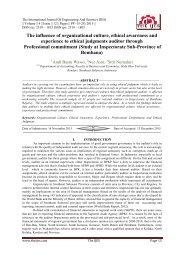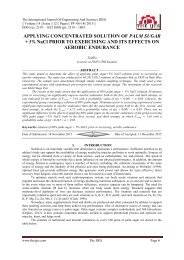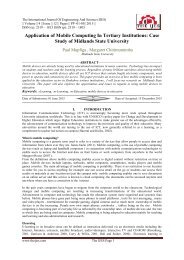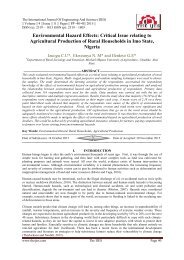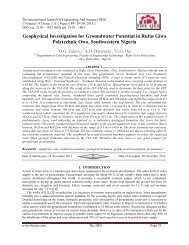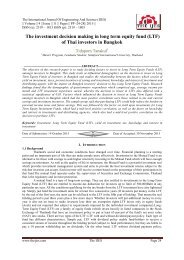ZigBee Technology for WPAN
You also want an ePaper? Increase the reach of your titles
YUMPU automatically turns print PDFs into web optimized ePapers that Google loves.
The International Journal Of Engineering And Science (IJES)<br />
|| Volume || 4 || Issue || 6 || Pages || PP.31-37 || June - 2015 ||<br />
ISSN (e): 2319 – 1813 ISSN (p): 2319 – 1805<br />
<strong>ZigBee</strong> <strong>Technology</strong> <strong>for</strong> <strong>WPAN</strong><br />
Suman Lata 1 , Mr. Naveen Goel 2<br />
P.G. Student, Department of ECE, Vaish College of Engineering, Rohtak, Haryana, India 1<br />
Head of Department (HOD), Department of ECE, Vaish College of Engineering, Rohtak, Haryana, India 2<br />
--------------------------------------------------------ABSTRACT-------------------------------------------------------------<br />
A <strong>ZigBee</strong> <strong>Technology</strong> is a latest technology that is used in wireless sensor network <strong>for</strong> controlling and<br />
monitoring data with low cost, low consumption of power and time-consuming battery life. <strong>ZigBee</strong> network<br />
provide self-organized and Self-healing network in which various patterns of data traffic is managed. It is used<br />
in those applications in which data is controlled and managed by using of sensing devices. Low consumption of<br />
power provides time-consuming battery life, high reliability and bulky area range is provided by Mesh<br />
networking. This paper presents introduction, design, implementation, and characteristics of <strong>ZigBee</strong> network. In<br />
different technology of wireless communication <strong>for</strong> LR-<strong>WPAN</strong>, <strong>ZigBee</strong> has many features like as low cost, low<br />
consumption of power, time-consuming battery life and low data rate.<br />
KEYWORDS: Low rate Wireless personal area network (<strong>WPAN</strong>), direct sequence spread spectrum<br />
(DSSS),Binary phase shift keying (BPSK), quadrature phase shift keying (O-QPSK), Carrier sense<br />
multiple access with collision avoidance (CSMA-CA), Medium access control (MAC)<br />
----------------------------------------------------------------------------------------------------------------------------- ----------<br />
Date of Submission: 05-June-2015<br />
Date of Accepted: 15-June-2015<br />
----------------------------------------------------------------------------------------------------------------------------- ----------<br />
I. INTRODUCTION<br />
A <strong>ZigBee</strong> is an IEEE802.15.4 standard that is used <strong>for</strong> <strong>WPAN</strong>. <strong>ZigBee</strong>\IEEE 802.15.4 is a standard<br />
based wireless technology that allows constituting a <strong>WPAN</strong>. Sensing within wireless networks is the main use<br />
of <strong>ZigBee</strong> due to very low consumption of power. <strong>ZigBee</strong> provides connectivity between small packet devices.<br />
LR-<strong>WPAN</strong>/<strong>ZigBee</strong> is used <strong>for</strong> devices that have less data rates, low consumption of power and are thus<br />
characterize by long battery life. Main objectives of LR-<strong>WPAN</strong> are simple installation; data transfer is very<br />
reliable, very low cost, time-consuming battery life, operation of short range. <strong>ZigBee</strong> is designed <strong>for</strong><br />
applications that need to transmit small quantity of data while being battery powered so the architecture of the<br />
protocols and the hardware is optimized <strong>for</strong> low consumption of power of end devices. It provides timeconsuming<br />
battery life. The application of a <strong>ZigBee</strong> network are home and building control, automation,<br />
wireless sensor network, security, industry control, medical controls, remote control, interactive toys. <strong>ZigBee</strong><br />
technology is used <strong>for</strong> these applications that offer time-consuming battery life, reliability of data transfer, the<br />
capability to add or remove nodes easily within network and low cost of system.<br />
II. ZIGBEE ARCHITECTURE<br />
<strong>ZigBee</strong> standard is established by <strong>ZigBee</strong> alliance. In 2002, <strong>ZigBee</strong> alliance has <strong>for</strong>med as a<br />
organization of nonprofit. <strong>ZigBee</strong> standard has adopted MAC (medium access control) layer and physical layer<br />
(PHY) of IEEE 802.15.4 standard. Main use of <strong>ZigBee</strong> networks is in sensor networks of low duty cycle (
<strong>ZigBee</strong> <strong>Technology</strong> <strong>for</strong> <strong>WPAN</strong><br />
The IEEE 802.15.4 tells how to establish a connection to a coordinator and disestablish a connection<br />
from a coordinator and how to convey messages between End devices and Coordinator. <strong>ZigBee</strong> standard consist<br />
of four layers i.e. the PHY layer, MAC layer, NWK layer and APP layer. The lowest layer i.e. PHY layer and<br />
MAC layer is defined by IEEE 802.15.4 standard. The <strong>ZigBee</strong> specification defines NWK layer, security service<br />
and APP layer in which configuration of a network, manipulation and routing of message is provided by<br />
network layer, and the intended function of the device is provided by APP layer.<br />
2.1 <strong>ZigBee</strong> characteristics<br />
<strong>ZigBee</strong>/IEE 802.15.4 standard include the features of low power consumption needed <strong>for</strong> only two<br />
major modes i.e. Tx/Rx or sleep, low data rates, high density of nodes per network, low cost and simple<br />
implementation. These features are provided by the following characteristics:<br />
‣ Low power consumption: <strong>ZigBee</strong> consume low power that provides longer battery life with ranging<br />
from months to years.<br />
‣ Low cost: <strong>ZigBee</strong> provides low cost of a device, low cost of an installation and low cost of a<br />
maintenance.<br />
‣ Data rates: 20Kbps@868MHz; 40 Kbps@902-928 MHz and 250Kbps@2.4GHz.<br />
‣ Channel access: Two modes that are used to access of channel. First mode is Carrier sense multiple<br />
access with Collision avoidance(CSMA-CA)<br />
‣ Addressing space: up to 64 bit IEEE Address devices, 65,535 networks.<br />
‣ Typical range from 10 to 70m.<br />
‣ Completely reliable “hand-shake” protocol of data transfer<br />
‣ Different network topologies are used i.e. Star topology, Tree topology and Mesh topology.<br />
‣ Low latency and high throughput <strong>for</strong> low duty cycle sensor networks.<br />
2.2 frequency band<br />
<strong>ZigBee</strong> devices operate in unlicensed radio frequency band(ISM). ISM radio band includes 27 channels<br />
categories in three frequency bands i.e. first is 868 MHz, second is 902-928 MHz and third is 2.4 GHz.<br />
www.theijes.com The IJES Page 32
<strong>ZigBee</strong> <strong>Technology</strong> <strong>for</strong> <strong>WPAN</strong><br />
In range of 868 MHz, channel 0 will be operating and 20 Kbps data rates; in the range of 902-928 MHz,<br />
channel 1-10 will be operating and 40 Kbps data rates; Remaining channel of 2.4 GHz frequency band is 11 to<br />
26 will be operating and 250 Kbps data rate. 2.4 GHz is more well-liked frequency band because of; it is used as<br />
worldwide. 868 MHz is primarily used <strong>for</strong> European whereas 902-928 MHz frequency band is used in Canada,<br />
United States, a few others countries. Frequency band of 2.4 GHz has higher data rates i.e. 250 Kbps and<br />
worldwide availability because of it, this is most advantageous frequency band. In this frequency band, offset<br />
Modulation technique of Offset-Quadrature phase shift keying (O-QPSK) is used. In other frequency band i.e.<br />
868 and 902-928 frequency band, direct sequence spread spectrum (DSSS) is used with Modulation technique<br />
of binary phase shift keying (BPSK). The use of O-QPSK and BPSK reduce complexity and minimize power<br />
consumption.<br />
2.3 Mode of operation<br />
<strong>ZigBee</strong> employs either of two modes, beacon or non-beacon<br />
Beacon mode: Beacon mode is used when coordinator runs on batteries and thus offers maximum power<br />
savings.<br />
Non-Beacon network: In non beacon mode, devices are „asleep‟ nearly, as in Burglar alarms and Smoke<br />
detectors. The devices get up and sure their presence continued at random intervals within the network<br />
www.theijes.com The IJES Page 33
<strong>ZigBee</strong> <strong>Technology</strong> <strong>for</strong> <strong>WPAN</strong><br />
2.4 CHANNEL ACCESS AND ADDRESSING<br />
In IEEE 802.15.4, two mechanisms are implemented <strong>for</strong> accessing a channel. In a beacon enabled<br />
network, first mechanism of a channel access is slotted CSMA-CA (Carrier Sense Medium Access – Collision<br />
Avoidance). CSMA-CA communicates with +ve acknowledgment <strong>for</strong> received packets successfully. Slotted<br />
CSMA/CA is also used to transmit data. Second mechanism <strong>for</strong> accessing a channel is Superframe structure i.e.<br />
used to channel access. Superframe is a setup by the coordinator of a network to transmit beacon at predefined<br />
interval and is separated into 16 equally sized slots. Beacon in the first slot of each Superframe is transmitted.<br />
Beacon is used to start Superframes, synchronize with other devices and announce the existence of a PAN and<br />
in<strong>for</strong>m pending data in coordinators. Superframe is characterized into 2 parts i.e. active and inactive period.<br />
Each portion is equal to 8 slots. Active period of Superframe is known as Superframe duration. Each active<br />
period is further characterized into two parts that is called CAP (contention access period) and CFP (contention<br />
free period). GTS (Granted time slots) is a group of time slots. Within the CFP, it contains up to 7 GTSs and.<br />
and each GTS contains many time slots. Data of each GTS can transfer either in the direction of transmit that is<br />
from child node to parent node (flow of upstream) or in the direction of receive (flow of downstream).Complete<br />
portion of active and inactive period is called as a BI (beacon interval) or Superframe. The time among two<br />
succeeding periods is called as Beacon interval or Superframe.<br />
.<br />
The Superframe structure is controlled by two parameters that is Superframe Order (SO) and Beacon<br />
Order (BO). The Superframe length is defined by BO and the length of an active period of Superframe is also<br />
defined by SO parameters. In a beacon enabled network, the BO and SO parameters should assure the condition<br />
0 ≤ SO ≤ BO ≤ 14 <strong>for</strong> 11 to 26 channels.<br />
www.theijes.com The IJES Page 34
<strong>ZigBee</strong> <strong>Technology</strong> <strong>for</strong> <strong>WPAN</strong><br />
BI=abaseSuperframeduration.2 BO<br />
SD=abaseSuperframeduration.2 SO<br />
The range of Superframe length (abaseSuperframeduration) can be from 15.36 mSec to 215.7 Sec. active period<br />
of each device will be 2 -(BO-SO) and sleep period will be 1-2 -(BO-SO) .<br />
IEEE 802.15.4 standard has 4 basic frame types which are beacon frame, data frame, acknowledgement (ACK)<br />
frame and MAC frame.<br />
Beacon frame: Coordinator uses beacon frame to convey beacons. It wake up client devices which listen <strong>for</strong><br />
their address and go back to sleep if they do not receive it.<br />
Data frame: Data frame is used <strong>for</strong> transfer of all data. It allowed a payload of up to 104 bytes. The frame is<br />
numbered to confirm that all packets are tracked and Frame check sequence (FCS) confirms that without errors<br />
of packets are received. It increases reliability in different condition.<br />
ACK frame: Successful frame reception is confirmed by using ACK frame. Feedback from receiver to sender is<br />
provided to confirm that the packets were received with no error.<br />
MAC frame: all MAC peer entity control transfer is handled by using MAC frame. It allows the mechanism <strong>for</strong><br />
arrangement of client nodes and remote control.<br />
2.5 DEVICE ADDRESSING<br />
The <strong>ZigBee</strong> standard contains 64-bit addresses and short addresses of 16-bit. When more<br />
devices communicate on the same physical channel create a <strong>WPAN</strong>. A <strong>WPAN</strong> contains at least one<br />
PAN coordinator that is a full function device (FFD). Each device with in a network contains a unique<br />
64 bits extended address.PAN uses 64 bits address <strong>for</strong> direct communication. A device contains 16<br />
bits short address that is used by PAN coordinator <strong>for</strong> association of device with its coordinator. Short<br />
address supports 65535 nodes with in network.<br />
III. DEVICE TYPE<br />
The device type which is used in a LR-<strong>WPAN</strong> is defined by IEEE 802.15.4 standard which are FFD<br />
and RFD. There are two device types:<br />
1. FFD is used <strong>for</strong> control and monitoring of sensing in<strong>for</strong>mation. FFD operate in 3 modes by serving as End<br />
devices, Routers and PAN coordinator. FFD is used as a simple device, as a coordinator, as PAN coordinator. It<br />
communicates with either other RFD or FFD. PAN coordinator always remains fixed but end devices and<br />
routers are either fixed or movable. Knowledge of overall network is managed by FFD. Power computing and<br />
most memory is required by it. It can become a coordinator of network and talk to any other devices.<br />
2. In simple application, RFD is used because it doesn‟t require transmitting small amounts of data and it has to<br />
communicate only with a specific FFD. FFD operates in only one mode by serving as Device. RFD can‟t used<br />
as a coordinator of a network but it talks to coordinator of a network. It has very easy implementation that is<br />
restricted to Star topology. RFD is only used <strong>for</strong> sensing in<strong>for</strong>mation.<br />
IV. NETWORK TOPOLOGY<br />
IEEE 802.15.4/ZIGBEE has 3 types of network topology i.e.<br />
I. Star topology<br />
II. Peer to Peer topology<br />
III. Mesh topology<br />
1) Star topology: in this topology, a coordinator is used and all other devices are associated with coordinator<br />
are end devices. A coordinator is responsible <strong>for</strong> the network and all end devices talk directly with the<br />
coordinator. In a time critical applications, this topology is perfect <strong>for</strong> networks with a centralize device.<br />
www.theijes.com The IJES Page 35
<strong>ZigBee</strong> <strong>Technology</strong> <strong>for</strong> <strong>WPAN</strong><br />
2) Peer to Peer topology: Here devices are placed closed enough together to create a successful communication<br />
link, device can communicate directly with any other device.<br />
All FFDs participate in relaying the messages. Cluster tree topology is a <strong>for</strong>m of peer to peer network. Initial<br />
network is established by a PAN coordinator in cluster tree topology. Coordinators create branches further after<br />
that relay messages. End devices don‟t participate in routing of message.<br />
3) Mesh topology: in this topology, coordinators are responsible <strong>for</strong> network initiating and maintenance.<br />
Network can be extended by using of routers. A mesh network is called Self-Healing so that if a node fails <strong>for</strong><br />
delivery of data other route is used to transfer data.<br />
Figure5: <strong>ZigBee</strong> Network Topology<br />
www.theijes.com The IJES Page 36
<strong>ZigBee</strong> <strong>Technology</strong> <strong>for</strong> <strong>WPAN</strong><br />
CONCLUSION<br />
In communication technology, <strong>ZigBee</strong> will be most useful in future. <strong>ZigBee</strong> is very useful where a<br />
large number of nodes are used with small data packets. In this paper, we studied about <strong>ZigBee</strong> technology in<br />
which in<strong>for</strong>mation about <strong>ZigBee</strong> is included. In different wireless communication technology <strong>for</strong> LR-<strong>WPAN</strong>,<br />
we found that <strong>ZigBee</strong> is perfect where low cost, low consumption of power, reliability in data transfer and timeconsuming<br />
battery life, need of small amount of data, low data rate are required. Some applications where<br />
<strong>ZigBee</strong> is perfect <strong>for</strong> wireless communication are home automation, building automation, wireless sensor<br />
network, medical control, remote control and sensor, industry control etc.<br />
REFERENCES<br />
[1] Li Pengfei, Li Jiakun, Nie Luhua, Wang Bo, “Research and Application of Zigbee Protocol Stack” IEEE International<br />
Conference on Measuring <strong>Technology</strong> and Mechatronics Automation, 2010.<br />
[2] Kim, W.H. and Lee, S. and Hwang, J., “Real-time Energy Monitoring and Controlling System based on <strong>ZigBee</strong> Sensor<br />
Networks”, Elsevier Procedia Computer Science (PCS), 2011.<br />
[3] Zhang, Q. and Sun, Y. and Cui, Z., “Application and analysis Of <strong>ZigBee</strong> technology <strong>for</strong> Smart Grid”, IEEE International<br />
Conference on Computer and In<strong>for</strong>mation Application (ICCIA), 2010.<br />
[4] Yang Li, Ji Maorong, GAO Zhenru, Zhang Weiping, Guo Tao, “Design of Home Automation System based on Zigbee Wireless<br />
Sensor Network” IEEE International Conference on In<strong>for</strong>mation Science and Engineering (ICISE), 2009.<br />
[5] Han, J. and Lee, H. and Park, K.R., “Remote-controllable and energy-saving room architecture based on <strong>ZigBee</strong><br />
Communication”, IEEE Transactions on Consumer Electronics (TCE), 2009.<br />
[6] B. Paolo, P. Prashant, W. C. Vince, C. Stefano, G. A. G, and H. Yfun ,“Wireless sensor networks: A survey on the state of art<br />
and the 802.15.4 and zigbee standards,” Computer Communications, vol. 30, pp. 1655–1695, 2007.<br />
[7] “IEEE Std. 802.15.4-2003/2006/2011, IEEE Standard <strong>for</strong> Wireless Medium Access Control (MAC) and Physical Layer (PHY)<br />
Specifications <strong>for</strong> Low-Rate Wireless Personal Area Networks (LR<strong>WPAN</strong>s)”, October 2003, September 2006, June, 2011.<br />
[8] <strong>ZigBee</strong> Specification, http://www.zigbee.org.<br />
[9] “A True System-on-Chip solution <strong>for</strong> 2.4 GHz IEEE 802.15.4 <strong>ZigBee</strong>”,http://focus.ti.com/docs/prod/folders/print/cc2430.html,<br />
March 2011.<br />
[10] You Ke, Liu Ruiqiang and Zhang Cuixia, “Work Mode of <strong>ZigBee</strong> WSN,” International Conference on In<strong>for</strong>mation Management,<br />
Innovation Management and Industrial Engineering ICIII, vol. 2, pp.536-538, 2008.<br />
[11] Renesas Electronics “<strong>ZigBee</strong> Overview” Internet:<br />
http://am.renesas.com/applications/key_technology/connectivity/zigbee/index.jsp, 2010 [Oct. 24, 2012].<br />
[12] <strong>ZigBee</strong> Alliance, <strong>ZigBee</strong> Specifications, version 1.0, April 2005.<br />
[13] Zhang, Q. and Sun, Y. and Cui, Z., “Application and analysis of <strong>ZigBee</strong> technology <strong>for</strong> Smart Grid”, IEEE International<br />
Conference on Computer and In<strong>for</strong>mation Application (ICCIA), 2010.<br />
www.theijes.com The IJES Page 37


